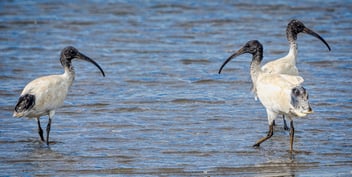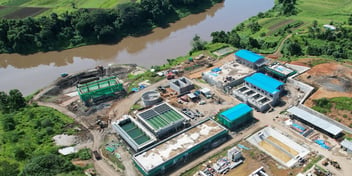Unlocking water security for communities, industries and the environment

As climate change and population growth continue to place pressure on assets and water supplies, Integrated Water Management (IWM) solutions are going to play a crucial role in achieving water security for communities, industries and the environment.
Stepping into the role of CEO of AECOM’s Australia & New Zealand region last October, Mark McManamny said IWM is a core capability of AECOM’s business, and for good reason.
“Our purpose as an organisation is about delivering a better world, whether that’s for the environment, communities, or for our clients. When we look at IWM, it fits really nicely into our purpose,” he said.
“Traditionally, water has been about solving problems on a linear or singular basis. We’ve come up with a lot of quite individual ways of dealing with different problems in the past.
“The concept of IWM is about taking each of those challenges and bringing them together, where a solution in one of those streams provides a benefit for another. Through that, we are achieving a much better use of the resource, and that’s critical under a changing climate.”
McManamny’s vision for AECOM’s ANZ region is to drive IWM approaches and solutions to make much better use of water across multiple industries.
“We are a really diverse business and the opportunity for us lies in connecting an IWM systematic approach into a lot of the other sectors that we operate within,” he said.
“Water spans across all of the other sectors we work within, including transport, construction and environment. We have an opportunity to take some of the innovative practices coming from the water industry and embed them more broadly into other sectors.
“For me, this is really exciting. It gives us a chance to help change attitudes and outcomes around water use in a number of those sectors. It’s an opportunity for us to make a real difference.”
A changing climate
Climate change is leading to increased variability in weather conditions, including droughts, floods and storms, and McManamny said IWM approaches and solutions are going to be a crucial element of how we tackle water scarcity issues.
“As we address the impacts of climate change, we need to be adjusting our approach, and IWM has a huge role to play in the improved use of water. We are also seeing significant population growth in some areas, which is placing additional pressure on existing assets and supplies,” he said.
“We want to work on how to start using IWM to identify alternative water sources or to use existing water sources in a more effective or efficient way. And we should likely be having conversations in Australia now about expanding our level of recycled water reuse.
“The IWM approach gives us opportunities to reuse wastewater or stormwater for improved outcomes for those growing communities as we head into a drier climate.”
McManamny said another key climate crisis challenge that IWM can help to solve is the increasing need for water in renewable energy generation.
“We need to appreciate that climate change is driving us towards alternative energy sources. As we move away from fossil fuels towards renewables, the use of water in the generation of energy becomes a really important issue to address,” he said.
“Green hydrogen is a newly forming market here in Australia and one that is heavily reliant on water. We need different processes and practices in place so that we are not using the wrong type of water to deliver those green hydrogen outcomes.
“We need to be looking at how we can reuse other water sources to support the budding green hydrogen industry. And there’s a key role for IWM in supporting that shift.”
Creating co-benefit
While waste-to-energy is a key focus area for AECOM, McManamny said the systems thinking involved in IWM approaches often leads to fantastic opportunities to achieve co-benefits in many areas of operation and planning, particularly around environmental benefits.
“IWM is a fascinating area to work within right now because the change is really starting to accelerate. The work we are engaged in at the moment is at the front end of this change. We are seeing a maturation of IWM approaches,” he said.
“A great example is our work with Bundaberg Regional Council. We were engaged to develop a concept design to replace an existing stormwater drainage channel.
“We are shifting that concrete channel into an integrated open space that provides water quality benefits, environmental outcomes, and habitat for flora and fauna, and also a benefit to the community as an open green-blue space.
“In the last 10 years, we have seen an increase in peak storm events. If we are going to keep up with that, we need to create resilience within existing infrastructure, through the development of these types of projects that allow us to continue to operate our water system.”
Nature-based solutions are complementary to IWM, McManamny said, offering opportunities to deliver environmental benefits, support improved biodiversity, and reuse water to become change agents for the environment.
“We are also currently working with the Great Barrier Reef Foundation on how we can start to disrupt traditional road drainage infrastructure to deliver better water quality outcomes through runoff that reaches the reef,” he said.
“We have been considering how to improve road drainage for many years, but when you start to consider it around a broader challenge, like protecting the reef, we start to think differently about how to apply some of those technologies and techniques.”
Future directions
One of the areas that McManamny is keen to see progress is the use of digital in IWM, particularly in terms of continuing to improve outcomes.
“What’s exciting is the use of AI and machine learning to support decision making on investment around IWM, and a lot of the planning decisions that are taking place,” he said.
“Taking a digital approach can help support the development and implementation of new ideas. A lot of the work we do in the water space is still quite rote, it requires a lot of manual investment. Digital allows us to test those ideas much faster.”
Aside from the broader implementation of digital within the IWM space, McManamny said industries also need to become more collaborative, but there’s already notable benefits being gained from the necessary shift towards more long-term partnerships.
“A lot of our clients are moving to longer-term partnership agreements. We are starting to see multi-year contracts between ourselves and our clients to support the technical development of design, planning and outcomes,” he said.
“This allows us to take a more programmatic approach to the delivery of those services. It allows innovation to continue to evolve.
“Rather than starting back at square one every time we secure a contract, we are actually building on the knowledge that's gone before, on the ideas that have already been put into place, and on the relationship and the trust that gets built between all the parties involved.
That is a great environment in which to foster digital innovation and to trial different ideas. It also helps us continue to move forward, without the stop-start nature of individual engagements.



